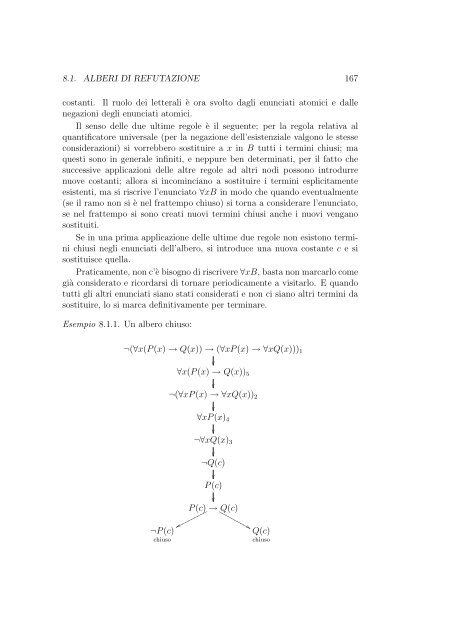Logica Matematica Corso di Laurea in Informatica ... - Mbox.dmi.unict.it
Logica Matematica Corso di Laurea in Informatica ... - Mbox.dmi.unict.it
Logica Matematica Corso di Laurea in Informatica ... - Mbox.dmi.unict.it
You also want an ePaper? Increase the reach of your titles
YUMPU automatically turns print PDFs into web optimized ePapers that Google loves.
8.1. ALBERI DI REFUTAZIONE 167<br />
costanti. Il ruolo dei letterali è ora svolto dagli enunciati atomici e dalle<br />
negazioni degli enunciati atomici.<br />
Il senso delle due ultime regole è il seguente; per la regola relativa al<br />
quantificatore universale (per la negazione dell’esistenziale valgono le stesse<br />
considerazioni) si vorrebbero sost<strong>it</strong>uire a x <strong>in</strong> B tutti i term<strong>in</strong>i chiusi; ma<br />
questi sono <strong>in</strong> generale <strong>in</strong>f<strong>in</strong><strong>it</strong>i, e neppure ben determ<strong>in</strong>ati, per il fatto che<br />
successive applicazioni delle altre regole ad altri no<strong>di</strong> possono <strong>in</strong>trodurre<br />
nuove costanti; allora si <strong>in</strong>com<strong>in</strong>ciano a sost<strong>it</strong>uire i term<strong>in</strong>i esplic<strong>it</strong>amente<br />
esistenti, ma si riscrive l’enunciato ∀xB <strong>in</strong> modo che quando eventualmente<br />
(se il ramo non si è nel frattempo chiuso) si torna a considerare l’enunciato,<br />
se nel frattempo si sono creati nuovi term<strong>in</strong>i chiusi anche i nuovi vengano<br />
sost<strong>it</strong>u<strong>it</strong>i.<br />
Se <strong>in</strong> una prima applicazione delle ultime due regole non esistono term<strong>in</strong>i<br />
chiusi negli enunciati dell’albero, si <strong>in</strong>troduce una nuova costante c e si<br />
sost<strong>it</strong>uisce quella.<br />
Praticamente, non c’è bisogno <strong>di</strong> riscrivere ∀xB, basta non marcarlo come<br />
già considerato e ricordarsi <strong>di</strong> tornare perio<strong>di</strong>camente a vis<strong>it</strong>arlo. E quando<br />
tutti gli altri enunciati siano stati considerati e non ci siano altri term<strong>in</strong>i da<br />
sost<strong>it</strong>uire, lo si marca def<strong>in</strong><strong>it</strong>ivamente per term<strong>in</strong>are.<br />
Esempio 8.1.1. Un albero chiuso:<br />
¬(∀x(P (x) → Q(x)) → (∀xP (x) → ∀xQ(x)))1<br />
¬P (c)<br />
chiuso<br />
<br />
∀x(P (x) → Q(x))5<br />
<br />
¬(∀xP (x) → ∀xQ(x))2<br />
<br />
∀xP (x)4<br />
<br />
¬∀xQ(x)3<br />
<br />
¬Q(c)<br />
<br />
P (c)<br />
<br />
P (c) → Q(c)<br />
<br />
<br />
<br />
<br />
Q(c)<br />
chiuso




![Introduzione ai sistemi Wiki [PDF] - Mbox.dmi.unict.it](https://img.yumpu.com/16413205/1/184x260/introduzione-ai-sistemi-wiki-pdf-mboxdmiunictit.jpg?quality=85)











